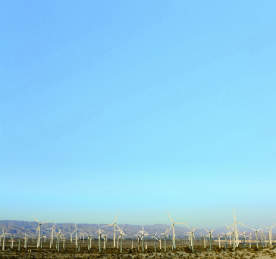As the American Wind Energy Association’s ‘US Wind Industry Third Quarter 2013 Market Report’ reveals, the US wind energy market was set to finish 2013 imbued with strong momentum. Having blasted through its 60GW installed wind capacity target, it now has a wealth of installations on the cards. Carl Levesque of the association sets the scene.

The US wind energy industry achieved its best year ever in 2012, shattering numerous records: it installed 13,131MW of capacity and surged past the 60GW milestone for total installed wind power capacity. Last year, the industry invested more than $25 billion in private capital to build new wind projects in the US, pushing the five-year average annual investment level to $18 billion between 2008 and 2012.
The result: for the first year ever, wind energy was the number-one source of new electricity-generating capacity, contributing 42% of the total megawatts installed by the power sector. More than 180 wind projects were built.
A record-breaking year
The 60GW installed today in the country represents enough electricity to power the equivalent of 15.2 million US homes, equal to all the households in the states of Colorado, Iowa, Maryland, Michigan, Nevada and Ohio combined. The 60GW of wind power now deployed will avoid nearly 100 million tons of CO2 each year, which equates to more than 4% of all power sector CO2 emissions.
Iowa and South Dakota now produce more than 20% of their electricity from wind energy, and some of the nation’s largest state economies have significant wind power penetrations.
While project activity has progressed at a red-hot pace, a shorter-term trend has emerged. The industry’s supply chain began to slow down as a result of the scheduled expiration of the federal wind energy production tax credit (PTC) at the end of 2012. Congress extended the PTC on 1 January 2013, which set in motion the steady build-up of momentum seen going into 2014 following the expected short-term dip in project construction that was triggered by the supply-chain slowdown.
The industry has grown rapidly in the US in recent years, despite the PTC being extended in short increments. As American Wind Energy Association CEO Tom Kiernan said upon the release of the body’s third-quarter market report: "It’s remarkable how much this industry has been able to accomplish despite the lack of policy certainty over the years."
Much of the reason for that success can be attributed to technological improvements, which are increasing the efficiency of turbines and driving down production costs.
The big utility sign-up
One key indicator of wind energy’s success and status as a familiar and mainstream energy source is evident when examining the electric utility side of the business. In addition to the industry’s record growth last year, another trend augured well for its future: new purchases of wind power were made by 74 electric utilities, along with at least 18 major industrial consumers, and 11 schools and universities. All of these organisations are taking advantage of the chance to diversify their energy portfolios, and stabilise and lower energy costs, typically via long-term, fixed-rate contracts.
This year, utilities have signed over 5,670MW of new power purchase agreements and received approval to build over 1,870MW of utility-owned wind power. These 7,500MW of new wind projects are helping to spur wind-manufacturing companies to once again increase hiring as well as driving construction projects. Ground was broken on an impressive 1,100MW of new projects during the third quarter, indicating a busy 2014.
The renewed push towards wind has included multiple utilities procuring significantly more wind energy than was called for in their initial request for proposals. Public Service Company of Oklahoma (PSO) decided to increase its purchase because of "extraordinary pricing opportunities that will lower costs for [PSO] customers by about $53 million in the first year of the contracts".
Thanks to innovation and hard work, the industry is ahead of schedule for achieving the milestone of producing 20% of the US’s electricity by 2030, as outlined in the US Department of Energy’s landmark 2008 feasibility report. In light of market dynamics that have emerged since the report’s publication, it was announced at the American Wind Energy Association’s WINDPOWER 2013 Conference & Exhibition that an initiative is now underway to update the report.
